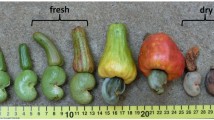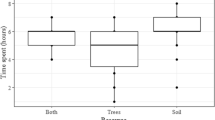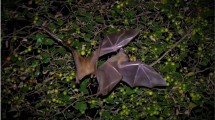Abstract
The sooty mangabey (Cercocebus atys) practices year-round durophagy. A large part of the C. atys diet consists of the oily nut of Sacoglottis gabonensis, which is accessed by post-canine crushing of the hard, protective seed coat. During a typical foraging bout, some seeds are discarded after initial crushing attempts using isometric biting, but the reason mangabeys reject some seeds and break into others is unclear. Although C. atys is sexually dimorphic, little is known about whether differences between males and females affect the selectivity of mechanically protected foods. We studied C. atys feeding on S. gabonensis in the Taï National Park, Côte d’Ivoire, in July and August 2016. Nuts discarded after an initial crushing attempt were collected and their hardness measured using a Shore D durometer. Measurements were taken in the region of the nut where monkeys attempted to crush it. Hardness values of nuts rejected by adult male (n = 79) and adult female (n = 104) C. atys were compared to those of a control assemblage of nuts collected randomly on the forest floor (n = 69). Nuts rejected by either sex do not differ statistically from the random sample; however, they do differ from each other, with females rejecting harder nuts. This suggests that males are more effective at broaching harder seed husks, and discard seeds based on other factors.





Similar content being viewed by others
References
Altmann SA (2009) Fallback foods, eclectic omnivores, and the packaging problem. Am J Phys Anthropol 140:615–629
Ayres JM (1989) Comparative feeding ecology of the uakari and bearded saki, Cacajao and Chiropotes. J Hum Evol 18:697–716
Bell RH (1971) A grazing ecosystem in the Serengeti. Sci Am 225:86–93
Boinski S (1988) Sex differences in the foraging behavior of squirrel monkeys in a seasonal habitat. Behav Ecol Sociobiol 23:177–186
Boinski S (1989) The positional behavior and substrate use of squirrel monkeys: ecological implications. J Hum Evol 18:659–677
Bowler M, Bodmer RE (2011) Diet and food choice in Peruvian red uakaris (Cacajao calvus ucayalii): selective or opportunistic seed predation? Int J Primatol 32:1109–1122
Buzzard PJ (2006) Ecological partitioning of Cercopithecus campbelli, C. petaurista, and C. diana in the Taï Forest. Int J Primatol 27:529–558
Chivers DJ, Hladik CM (1980) Morphology of the gastrointestinal tract in primates: comparisons with other mammals in relation to diet. J Morphol 166:337–386
Clutton-Brock TH (1977) Some aspects of infraspecific variation in feeding and ranging behaviour in primates. In: Clutton-Brock TH (ed) Primate ecology: studies of feeding and ranging behaviour in lemurs, monkeys and apes. Academic, New York, pp 539–556
Core Team R (2017) R: a language and environment for statistical computing. R Foundation for Statistical Computing, Vienna
Daegling DJ, McGraw WS (2007) Functional morphology of the mangabey mandibular corpus: relationship to dental specializations and feeding behavior. Am J Phys Anthropol 134:50–62
Daegling DJ, McGraw WS, Ungar PS, Pampush JD, Vick AE, Bitty EA (2011) Hard-object feeding in sooty mangabeys (Cercocebus atys) and interpretation of early hominin feeding ecology. PLOS ONE 6:e23095
Dasilva GL (1994) Diet of Colobus polykomos on Tiwai Island: selection of food in relation to its seasonal abundance and nutritional quality. Int J Primatol 15:655–680
Dounias E (2008) Sacoglottis gabonensis (Baill.) Urb. In Schmelzer GH, Gurib-Fakim A (eds). PROTA (plant resources of tropical Africa/Ressources végétales de l’Afrique tropicale). Retrieved from <https://database.prota.org/search.htm>. Accessed 14 April 2009
Dumont ER, Ryan TM, Godfrey LR (2011) The Hadropithecus conundrum reconsidered, with implications for interpreting diet in fossil hominins. R Soc B 278:3654–3661
Dunbar RIM, Dunbar P (1988) Maternal time budgets of gelada baboons. Anim Behav 36:970–980
Fleagle JG, McGraw WS (1999) Skeletal and dental morphology supports diphyletic origin of baboons and mandrills. Proc Natl Acad Sci USA 96:1157–1161
Fleagle JG, McGraw WS (2002) Skeletal and dental morphology of African papionins: unmasking a cryptic clade. J Hum Evol 42:267–292
Gautier-Hion A (1980) Seasonal variations of diet related to species and sex in a community of Cercopithecus monkeys. J Anim Ecol 49:237–269
Geissler E (2020) Cercocebus atys seed selection. osf.io/4dwej
Harrison MJ (1983) Age and sex differences in the diet and feeding strategies of the green monkey, Cercopithecus sabaeus. Anim Behav 31:969–977
Harrison MJ (1984) Optimal foraging strategies in the diet of the green monkey, Cercopithecus sabaeus, at Mt. Assirik, Senegal. Int J Primatol 5:435
Hill DA, Lucas PW (1996) Toughness and fiber content of major leaf foods of Japanese macaques (Macaca fuscata yakui) in Yakushima. Am J Primatol 38:221–231
Hylander WL (2012) Functional links between canine height and jaw gape in catarrhines with special reference to early hominins. Am J Phys Anthropol 150:247–259
Janson CH (1988) Intra-specific food competition and primate social structure: a synthesis. Behaviour 105:1–17
Jarman P (1974) The social organisation of antelope in relation to their ecology. Behaviour 48:215–267
Jin C, Ciochon RL, Dong W, Hunt RM, Liu J, Jaeger M, Zhu Q (2007) The first skull of the earliest giant panda. Proc Natl Acad Sci USA 104:10932–10937
Kamilar JM, Pokempner AA (2008) Does body mass dimorphism increase male–female dietary niche separation? a comparative study of primates. Behaviour 145:1211–1234
Kane EE, McGraw WS (2017) Dietary variation in Diana monkeys (Cercopithecus diana): the effects of polyspecific associations. Folia Primatol 88:455–482
Kinzey WG, Norconk MA (1990) Hardness as a basis of fruit choice in two sympatric primates. Am J Phys Anthropol 81:5–15
Kinzey WG, Norconk MA (1993) Physical and chemical properties of fruit and seeds eaten by Pithecia and Chiropotes in Surinam and Venezuela. Int J Primatol 14:207–227
McConkey KR, Ario A, Aldy F, Chivers DJ (2003) Influence of forest seasonality on gibbon food choice in the rain forests of Barito Ulu, Central Kalimantan. Int J Primatol 24:19–32
McGraw WS (1998) Posture and support use of Old World monkeys (Cercopithecidae): the influence of foraging strategies, activity patterns, and the spatial distribution of preferred food items. Am J Primatol 46:229–250
McGraw WS, Zuberbühler K (2007) The monkeys of the Taï Forest: an introduction. In: McGraw WS, Zuberbühler K, Noë R (eds) Monkeys of the Taï Forest: an African primate community. Cambridge University Press, Cambridge, pp 1–48
McGraw WS, Vick AE, Daegling DJ (2011) Sex and age differences in the diet and ingestive behaviors of sooty mangabeys (Cercocebus atys) in the Taï Forest, Ivory Coast. Am J Phys Anthropol 144:140–153
McGraw WS, Vick AE, Daegling DJ (2014) Dietary variation and food hardness in sooty mangabeys (Cercocebus atys): implications for fallback foods and dental adaptation. Am J Phys Anthropol 154:413–423
Milton K (1984) The role of food processing factors in primate food choice. In: Rodman PS, Cant JGH (eds) Adaptations for foraging in nonhuman primates: contributions to an organismal biology of prosimians, monkeys and apes. Columbia University Press, New York, pp 249–279
Nakagawa N (2003) Difference in food selection between patas monkeys (Erythrocebus patas) and tantalus monkeys (Cercopithecus aethiops tantalus) in Kala Maloue National Park, Cameroon, in relation to nutrient content. Primates 44:3–11
O’Mara MT, Hickey CM (2014) The development of sex differences in ring-tailed lemur feeding ecology. Behav Ecol Sociobiol 68:1273–1286
Pampush JD, Daegling DJ, Vick AE, McGraw WS, Covey RM, Rapoff AJ (2011) Converting durometer data into elastic modulus in biological materials. Am J Phys Anthropol 146:650–653
Pampush JD, Duque AC, Burrows BR, Daegling DJ, Kenney WF, McGraw WS (2013) Homoplasy and thick enamel in primates. J Hum Evol 64:216–224
Portman OW (1970) Nutrient requirements of monkeys. National Academy of Sciences–National Research Council Publication 990, Washington, DC
Range F, Noe R (2002) Familiarity and dominance relations among female sooty mangabeys in the Tai National park. Am J Primatol 56:137–153
Rose LM (1994) Sex differences in diet and foraging behavior in white-faced capuchins (Cebus capucinus). Int J Primatol 15:95–114
Silver SC, Ostro LET, Yeager CP, Dierenfeld ES (2000) Phytochemical and mineral components of foods consumed by black howler monkeys (Alouatta pigra) at two sites in Belize. Zoo Biol 19:95–109
Singleton M (2005) Functional shape variation in the cercopithecine masticatory complex. In: Slice DE (ed) Modern morphometrics in physical anthropology. Kluwer Academic/Plenum, New York, pp 319–348
Smith RJ, Jungers WL (1997) Body mass in comparative primatology. J Hum Evol 32:523–559
Smith AL, Benazzi S, Ledogar JA, Tamvada K, Pryor Smith LC, Weber GW, Spencer MA, Lucas PW, Michael S, Shekeban A, Al-Fadhalah K, Almusallam AS, Dechow CP, Grosse IR, Ross CF, Madden RH, Richmond BG, Wright BW, Wang Q, Byron C, Slice DE, Wood S, Dzialo C, Berthaume MA, van Casteren A, Strait DS (2015) The feeding biomechanics and dietary ecology of Paranthropus boisei. Anat Rec 298:145–167
Strait DS, Weber GW, Neubauer S et al (2009) The feeding biomechanics and dietary ecology of Australopithecus africanus. Proc Natl Acad Sci USA 106:2124–2129
Taniguchi H (2015) How the physical properties of food influence its selection by infant Japanese macaques inhabiting a snow-covered area. Am J Primatol 77:285–295
Tamura M (2020) Extractive foraging on hard-shelled walnuts and variation of feeding techniques in wild Japanese macaques (Macaca fuscata). Am J Primatol 82:e23130
Taylor AB, Terhune CE, Toler M, Holmes M, Ross CF, Vinyard CJ (2018) Jaw-muscle fiber architecture and leverage in the hard-object feeding sooty mangabey are not structured to facilitate relatively large bite forces compared to other papionins. Anat Rec 301:325–342
Tobias PV (1967) Olduvai Gorge. The cranium and maxillary dentition of Australopithecus (Zinjanthropus) boisei, vol. 2. Cambridge University Press, Cambridge, England
Tseng ZJ, Wang X, Stewart JD (2009) A new immigrant mustelid (Carnivora, Mammalia) from the middle Miocene Temblor Formation of central California. PaleoBios 29:13–23
van Schaik CP, Brockman DK (2005) Seasonality in primate ecology, reproduction, and life history: an overview. In: van Schaik CP, Brockman DK (eds) Seasonality in primates: studies of living and extinct human and non-human primates. Cambridge University Press, Cambridge, pp 3–20
van Schaik CP, van Noordwijk MA, Vogel ER (2009) Ecological sex differences in wild orangutans. In: Wich SA, Utami Atmoko SS, Mitra Setia T, van Schaik CP (eds) Orangutans: geographic variation in behavioral ecology and conservation. Oxford University Press, Oxford, pp 255–268
Vasey N (2000) Niche separation in Varecia variegata rubra and Eulemur fulvus albifrons. I. Interspecific patterns. Am J Phys Anthropol 112:411–431
Vogel ER (2005) Rank differences in energy intake rates in white-faced capuchin monkeys, Cebus capucinus: the effects of contest competition. Behav Ecol Sociobiol 58:333–344
Yamashita N (1996) Seasonally and site specificity of mechanical dietary patterns in two malagasy lemur families (Lemuridae and Indriidae). Int J Primatol 17:355–387
Acknowledgments
The authors are grateful to the Office Ivorien de Parcs et Réserves for permission to conduct the work described here. We also thank the Centre Suisse de Récherches Scientifiques for logistical support and the Taï Monkey Project field coordinator, Dr. Anderson Bitty, for support in preparation of and during the fieldwork. The authors are further grateful to the field assistants of the Taï Monkey Project and Alexandra Wilkins for all their assistance and advice during data collection. Many thanks to Paterson Kalo for his vital contributions in the field. Lastly, we also thank two anonymous reviewers for their constructive comments, which improved an earlier version of this manuscript. Data collection for this project followed the American Society of Primatologists’ principles for the ethical treatment of nonhuman primates, as well as the guidelines for permit-granting bodies in Côte d’Ivoire.
Funding
This study was funded by the National Science Foundation (BCS 0840110, 0921770, 0922429).
Author information
Authors and Affiliations
Corresponding author
Ethics declarations
Conflict of interest
The authors declare that they have no conflicts of interest.
Additional information
Publisher's Note
Springer Nature remains neutral with regard to jurisdictional claims in published maps and institutional affiliations.
About this article
Cite this article
Geissler, E., Daegling, D.J., Polvadore, T.A. et al. Seed choice differs by sex in sooty mangabeys (Cercocebus atys). Primates 62, 361–367 (2021). https://doi.org/10.1007/s10329-020-00863-w
Received:
Accepted:
Published:
Issue Date:
DOI: https://doi.org/10.1007/s10329-020-00863-w




